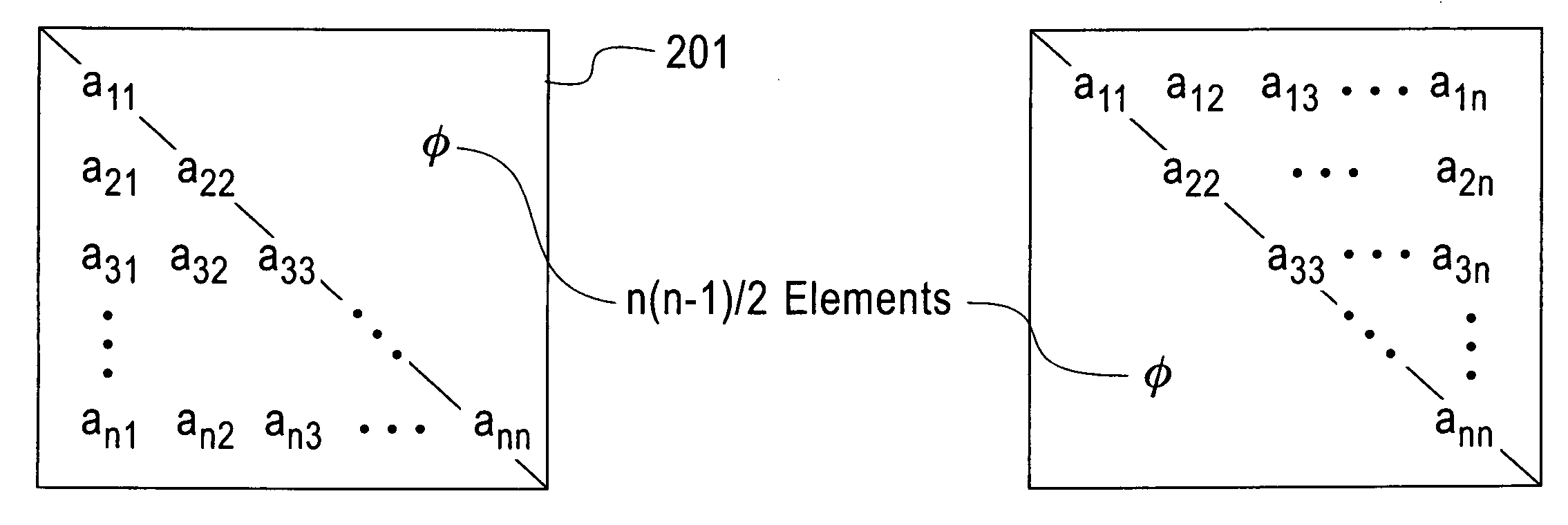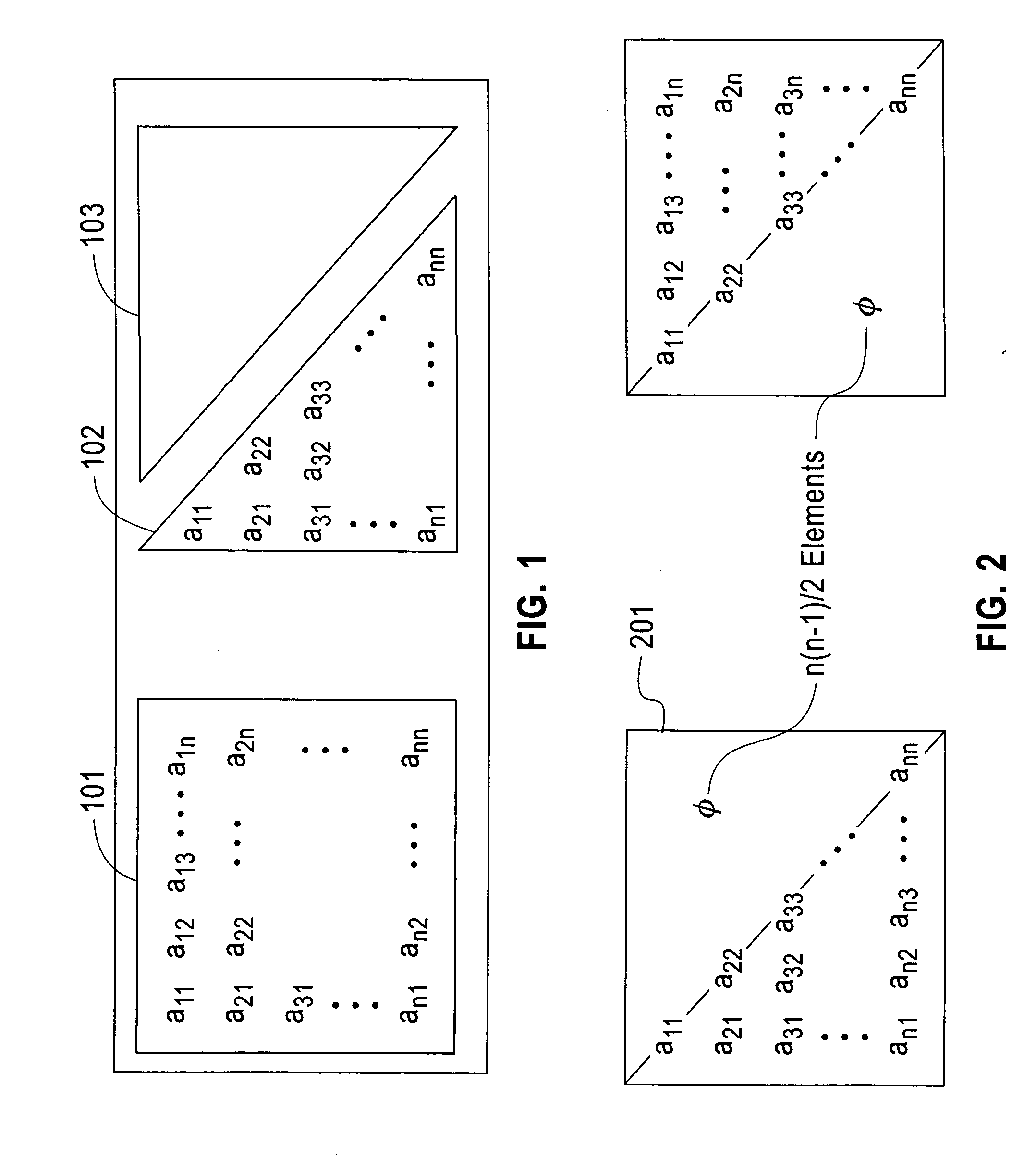Method and structure for improving processing efficiency in parallel processing machines for rectangular and triangular matrix routines
a parallel processing machine and triangular matrix technology, applied in the field of improving the processing efficiency of linear algebra routines, can solve the problems of reducing computation performance, wasting nearly half of triangular/symmetric matrix data stored in conventional methods in rectangular memory space, and adding a factor in data processing efficiency, so as to reduce storage
- Summary
- Abstract
- Description
- Claims
- Application Information
AI Technical Summary
Benefits of technology
Problems solved by technology
Method used
Image
Examples
first exemplary embodiment
Directly Mapping Triangular Matrix Only the Essential Data to the Processor Grid (the Block Packed Format)
[0099] In the first exemplary embodiment, superfluous triangular data is essentially eliminated by selectively mapping the substantially only the essential data, typically, in units of blocks of data (often referred to herein as “atomic blocks of contiguous data” because a preferred embodiment specifically incorporates contiguous data to be described later), onto the processor grid, using a column-by-column wrap-around mapping.
[0100]FIG. 4 exemplarily shows this wrap-around mapping 400 onto a 3×4 processor 402 for a lower triangular matrix 401 stored in memory with superfluous data 403. The mapping 400 begins at the data blocks of the left column 404 of essential data 401 by sequentially mapping the data blocks onto the first column 405 of the processor grid 402 in a wrap-around manner.
[0101] Remaining columns of matrix essential data blocks are also respectively mapped in a w...
second exemplary embodiment
The Second Exemplary Embodiment
The Hybrid Full-Packed Data Structure as Adapted to the Parallel Processor Environment to Eliminate Superfluous Data
[0123] The second embodiment, briefly mentioned above in a cursory description of FIG. 5, differs from the block packed cyclic distribution of the first embodiment in that the relevant data is first converted into the hybrid full-packed data structure described in either of the two above-identified co-pending applications. In developing the hybrid full-packed data structure concepts, the present inventors also recognized that the conventional subroutines for solving triangular / symmetric matrix subroutines on parallel machines have been constructed in modules that handle triangular data as broken down into triangular and rectangular portions.
[0124] Therefore, recognizing that the hybrid full-packed data structure inherently provides such triangular and rectangular portions of matrix data and that the hybrid full-packed data structure als...
embodiment 1
Details of Executing the Cholesky Factorization Process Using Embodiment 1
[0196] We shall give some further details about the lower Block Packed Cyclic algorithm. We shall not cover the upper case, as it is quite similar to the lower case. We now describe the mapping of a standard block (lower) packed array to our new block (lower) packed cyclic, a P by Q rectangular mesh, layout. Before doing so, we must define our new lower block pack cyclic LBPC layout on a rectangular mesh. The block order of our block packed global symmetric matrix ABPG is n. On a P by Q mesh, p(I,J) gets rows I+il·P, il=0, . . . , pe(I) and columns J+jl·Q, jl=0, . . . , qe(J). Here pe(I) and qe(J) stand for the end index values of il and jl. On the West border of p(I,J) we lay out pe(I)+1 send receive buffers and on the South border of p(I,J) we lay out qe(J)+1 send receive buffers. In FIG. 7, P=5, Q=3, n=18, pe(0:4)=4 4 4 3 3 and qe(0:2)=6 6 6.
[0197] Since ABPG can be viewed as a full matrix of order n, we c...
PUM
 Login to View More
Login to View More Abstract
Description
Claims
Application Information
 Login to View More
Login to View More - R&D
- Intellectual Property
- Life Sciences
- Materials
- Tech Scout
- Unparalleled Data Quality
- Higher Quality Content
- 60% Fewer Hallucinations
Browse by: Latest US Patents, China's latest patents, Technical Efficacy Thesaurus, Application Domain, Technology Topic, Popular Technical Reports.
© 2025 PatSnap. All rights reserved.Legal|Privacy policy|Modern Slavery Act Transparency Statement|Sitemap|About US| Contact US: help@patsnap.com



